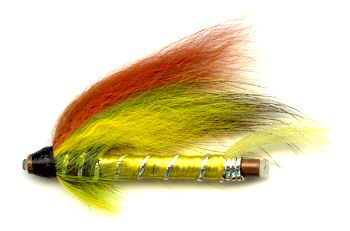The Green Highlander 1 1/2 Inch Copper Tube Fly
The heavy copper tube used in this Green Highlander 1 1/2 Inch Copper Salmon and Steelhead Tube fly pattern gets it down fast to where the fish our feeding. It is an ideal juvenile trout imitation. This pattern refuses to die because it still bring great results.

SALTWATER, SALMON & STEELHEAD TUBE FLY
$US each. Price does not include hooks.
The modern version of the famous fully dressed Green Highlander pattern uses hair-wing. It mixes colors of bucktail to form the wing rather than the feathers of the endangered exotic birds of the original. This method is used to update and improve many of the old traditional patterns. The original was designed during the latter part of the 19th century by Mr Grant of Wester, Elchies. The older fly called the highlander is considered the forerunner of the Green Highlander. It is notable as it is one of the few green classic salmon flies. For some reason, apart from the Green Highlander, green flies never became popular in Great Britain in times past unlike today.
The water temperature is one of the main factors that controls the depth at which a salmon fly should be fished. The salmon are less active in the cold waters of winter, spring and late autumn fall. They tend to lie deep near the bottom. Your fly has to be fished deep to where they are lying and this is where the weight of a copper tube fly helps to get your hook down fast to the correct level.
In the warmer summer months trout will rise to the surface to take a fly. This rarely happens the rest of the year. If you hold up feather or hairwing salmon fly against a bright sky you get a dark silhouette. This is what a summer salmon sees when it looks upward from the depth. Colour of your fly is less important in the summer than in the winter, early spring or late autumn. The reason for this is that your fly will be viewed at eye level during the colder months and not from underneath against a bright sky. You need brightly coloured as well as bigger flies in cold water.
If your pool is not very deep I have found a beaded crystal woolly bugger very successful salmon taker. In deeper pools you need the extra weight. This is when the copper tube fly comes into its own.
Backing-up is a way of fishing your salmon fly that really belongs in the peaty pools of a Scottish Highland river, down at the lower end of the strath, close to the sea. The pools are long and straight, the water is fairly shallow and flows, gently and evenly, over a gravel bottom across the whole width of the river. It is most likely the colour of a pint of British ale, but don’t let that fool you. The fish can see you even if you cannot see them.
Start at the downstream, tail end, of the pool and keep out of the water and well away from the bank. Cast fairly square across and, holding the rod up, let the fly come slowly right round, with no drag. Take three paces backwards upstream and cast again. Continue like this up to the head of the pool.
The salmon seem to be taken unawares by the fly coming from behind. They will all be looking upstream. They rise to the fly without the circumspection they normally exercise when it comes across in front of them. They have a chance to see it more than once and change their minds about taking it.
If you see a fish rise anywhere near where your fly is fishing, do nothing except let go the slack loop of line you hold under the butt. Raise the rod steady and firmly. With luck the fish will be on. Move downstream at once if a fish is hooked so as not to spook the other fish. Try to play your salmon in water you have already covered in previous casts.

